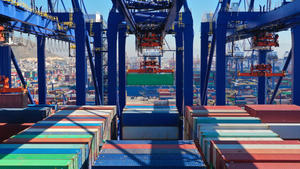The supply chain is broken, and there’s no easy fix. What’s contributing to the delays, and when will they get better? We’ve tapped furniture industry veteran and longtime editor Ray Allegrezza for a multipart series that unpacks the challenges at hand. In this first installment, he’s taking a closer look at how raw material shortages—and the price hikes that have followed—are rippling across the industry.
A reporter for The Wall Street Journal called the other day and wanted, like everyone else, to talk about the broken global supply chain. After I agreed, she challenged me to summarize the situation at hand in three sentences or less. I told her, “If a perfect storm married another perfect storm, and they had a baby, they would name it Supply Chain.”
“Perfect storm” isn't just a metaphor. When it comes to the current shortages of raw materials and subsequent price hikes, the pandemic certainly played a major role in this ongoing tale of woe—but it had plenty of help from a host of supporting actors, including Mother Nature. In February, severe ice storms shut down the power grid in the Gulf of Mexico, shuttering four major chemical plants in Texas and another in Louisiana, which drastically reduced the availability of chemicals needed to produce foam used for furniture. As a result, domestic upholstery makers across the spectrum—from Century Furniture to Craftmaster Furniture to Affordable Furniture Manufacturing—dramatically cut production. Thanks to scarce availability, price hikes followed closely behind.
Key upholstery sources began telling customers to expect a series of price hikes on goods, as well as with surcharges to help offset skyrocketing container and transportation costs. And since this was all part of the movie we are calling The Perfect Storm, this series of problems—raw material shortages; price hikes for fabric, foam, wood, metal and more; and related disruptions in trucking, logistics, workforce and beyond—hit precisely when demand was going through the roof.
According to industry analyst Kenneth D. Smith, managing partner at High Point, North Carolina–based accounting and advisory firm Smith Leonard, residential furniture orders spiked 27 percent in December 2020 compared to the same month in 2019. “Back in April [2020], who would have believed that we would have seen these results for the year?” Smith quipped of the sharp spike after the pandemic initially sent orders plummeting and industry brands steeled themselves for a long-term slowdown.
Now, deep into the fourth quarter of 2021, perhaps we should rename this horror show The Storm That Refuses to End.
Candidly, from where I sit, we are probably in the eye of the storm. While we’ve seen some return to life B.C. (Before COVID-19), looks can be deceiving. If you’ve been keeping up with what’s going on at ports in Los Angeles and Long Beach—the largest U.S. ports, they represent more than one-quarter of North America’s total container trade—you’ve seen the reports that the Biden Administration is pushing for 24/7 unloading of containers, with ships being fined for being in those ports for too long.
That sounds great on paper—but when I checked late last week, there were more than 153 ships at anchor waiting for dock space, and more than 100 of those were containerships, according to the Marine Exchange of Southern California.
To make life even more interesting, once a container actually gets offloaded from the port, good luck trying to find drivers, trucks, warehouse space and workers to keep the can moving.
Another indicator that industry challenges will persist is a just-tabulated survey taken among 1,500 independent sales reps who are members of the International Home Furnishings Representatives Association, a High Point–based group where I’ve served as executive director since 2018. Since sales reps work closely with suppliers, factories and retailers, they often have the best perspective of what is happening in real time. When the survey asked them to share how the pandemic has impacted their businesses and when they foresee these issues improving, 33 percent said mid-2022. Another 29 percent said late next year—and, tellingly, 30 percent said things would not improve until the very end of next year.
As much as the home furnishings sector is hurting, it’s far from the only one. Have you noticed the shelves recently at grocery stores, department stores and general merchandise chains? Just about every retail analyst I follow has been warning consumers to buy holiday gifts early and often. Here in the Coney Island of the mind we call Furnitureland, I think the new motto may be, “Don’t hold your breath.”
When will it all end? Not until we get our arms around raw material and container cost increases, worker and driver shortages, port congestion, demand that outpaces supply, and new strains of the virus—but those are topics for future columns. Watch this space.
Homepage photo: The Port of Long Beach in California | © Sergey Novikov/Adobe Stock
____________
Ray Allegrezza is the executive director of the International Home Furnishings Representatives Association, which was founded in 1934 to focus on the needs of the industry’s sales reps. An industry veteran with more than three decades of editorial, publishing and marketing experience in the home furnishings sector, Allegrezza was the editor in chief of Furniture Today from 1995 to 2014.




























